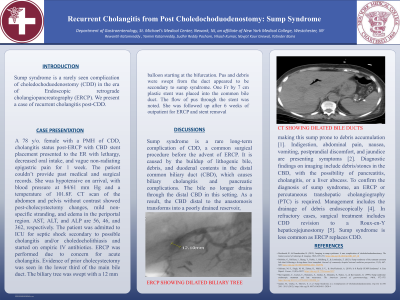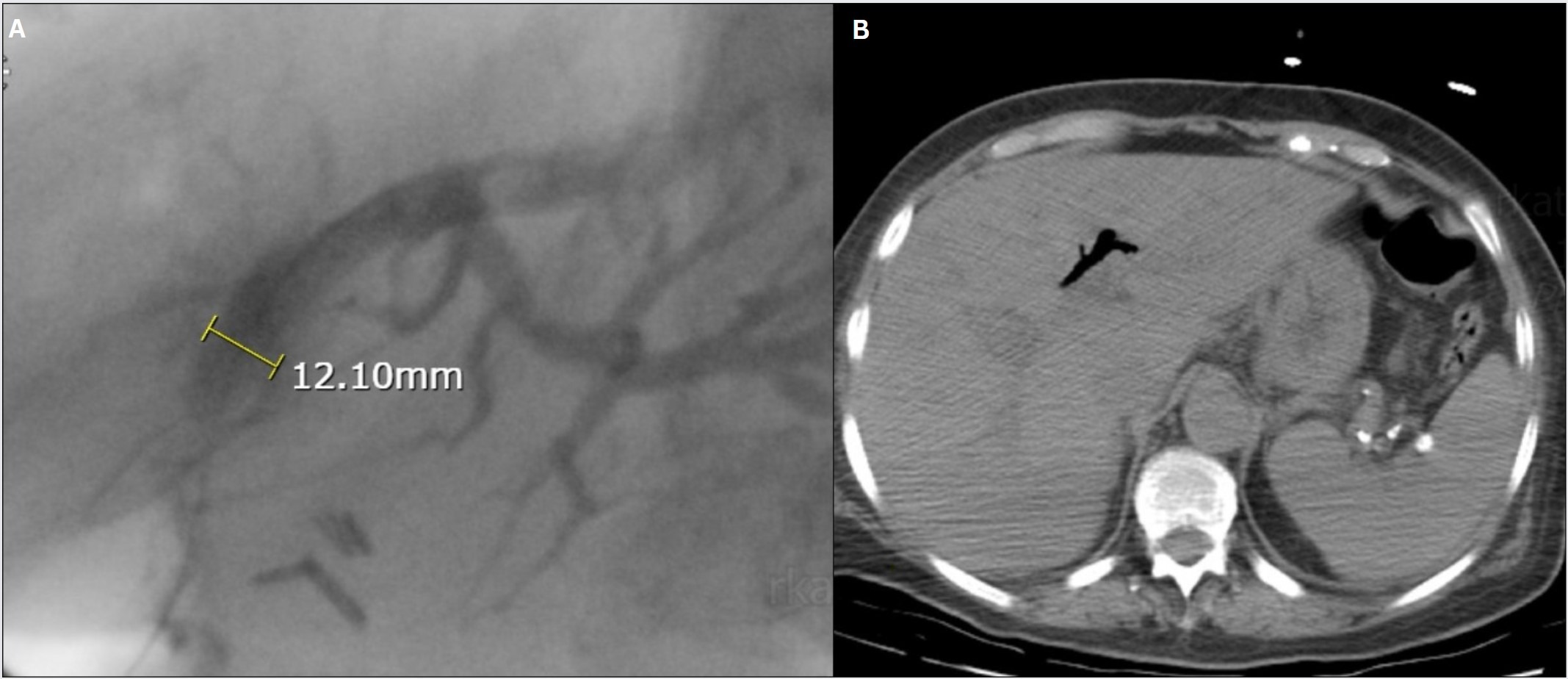Sunday Poster Session
Category: Biliary/Pancreas
P0120 - Recurrent Cholangitis from Post Choledochoduodenostomy: Sump Syndrome
Sunday, October 22, 2023
3:30 PM - 7:00 PM PT
Location: Exhibit Hall

Has Audio
- RK
Rewanth Katamreddy, MD
Saint Michael’s Medical Center
Newark, New Jersey
Presenting Author(s)
Rewanth Katamreddy, MD1, Yamini Katamreddy, MD2, Sudhir Reddy. Pasham, MD3, Vikash Kumar, MD4, Navjot Kaur Grewal, MD5, Yatinder Bains, MD5, Theodore DaCosta Jr., MD6
1Saint Michael’s Medical Center, Newark, NJ; 2West Anaheim Medical Center, Anaheim, CA; 3Guthrie Robert Packer Hospital, Sayre, PA; 4Brooklyn Hospital Center, Brooklyn, NY; 5Saint Michael's Medical Center, Newark, NJ; 6Saint Michael's Medical Center, New York Medical College, Newark, NJ
Introduction: Sump syndrome is a rarely seen complication of choledochoduodenostomy (CDD) in the era of Endoscopic retrograde cholangiopancreatography (ERCP). We present a case of recurrent cholangitis post-CDD.
Case Description/Methods: A 78 y/o. female with a PMH of CDD, cholangitis status post-ERCP with CBD stent placement presented to the ER with lethargy, decreased oral intake, and vague non-radiating epigastric pain for 1 week. The patient couldn’t provide past medical and surgical records. She was hypotensive on arrival, with blood pressure at 84/61 mm Hg and a temperature of 101.8F. CT scan of the abdomen and pelvis without contrast showed post-cholecystectomy changes, mild non-specific stranding, and edema in the periportal region. AST, ALT, and ALP are 56, 46, and 362, respectively. The patient was admitted to ICU for septic shock secondary to possible cholangitis and/or choledocholithiasis and started on empiric IV antibiotics. ERCP was performed due to concern for acute cholangitis. Evidence of prior cholecystectomy was seen in the lower third of the main bile duct. The biliary tree was swept with a 12 mm balloon starting at the bifurcation. Pus and debris were swept from the duct appeared to be secondary to sump syndrome. One Fr by 7 cm plastic stent was placed into the common bile duct. The flow of pus through the stent was noted. She was followed up after 6 weeks of outpatient for ERCP and stent removal.
Discussion:
Sump syndrome is a rare long-term complication of CDD, a common surgical procedure before the advent of ERCP. It is caused by the buildup of lithogenic bile, debris, and duodenal contents in the distal common biliary duct (CBD), which causes biliary cholangitis and pancreatic complications. The bile no longer drains through the distal CBD in this setting. As a result, the CBD distal to the anastomosis transforms into a poorly drained reservoir, making this sump prone to debris accumulation [1]. Indigestion, abdominal pain, nausea, vomiting, postprandial discomfort, and jaundice are presenting symptoms [2]. Diagnostic findings on imaging include debris/stones in the CBD, with the possibility of pancreatitis, cholangitis, or a liver abscess. To confirm the diagnosis of sump syndrome, an ERCP or percutaneous transhepatic cholangiography (PTC) is required. Management includes the drainage of debris endoscopically [4]. In refractory cases, surgical treatment includes CDD revision to a Roux-en-Y hepaticojejunostomy [5]. Sump syndrome is less common as ERCP replaces CDD.

Disclosures:
Rewanth Katamreddy, MD1, Yamini Katamreddy, MD2, Sudhir Reddy. Pasham, MD3, Vikash Kumar, MD4, Navjot Kaur Grewal, MD5, Yatinder Bains, MD5, Theodore DaCosta Jr., MD6. P0120 - Recurrent Cholangitis from Post Choledochoduodenostomy: Sump Syndrome, ACG 2023 Annual Scientific Meeting Abstracts. Vancouver, BC, Canada: American College of Gastroenterology.
1Saint Michael’s Medical Center, Newark, NJ; 2West Anaheim Medical Center, Anaheim, CA; 3Guthrie Robert Packer Hospital, Sayre, PA; 4Brooklyn Hospital Center, Brooklyn, NY; 5Saint Michael's Medical Center, Newark, NJ; 6Saint Michael's Medical Center, New York Medical College, Newark, NJ
Introduction: Sump syndrome is a rarely seen complication of choledochoduodenostomy (CDD) in the era of Endoscopic retrograde cholangiopancreatography (ERCP). We present a case of recurrent cholangitis post-CDD.
Case Description/Methods: A 78 y/o. female with a PMH of CDD, cholangitis status post-ERCP with CBD stent placement presented to the ER with lethargy, decreased oral intake, and vague non-radiating epigastric pain for 1 week. The patient couldn’t provide past medical and surgical records. She was hypotensive on arrival, with blood pressure at 84/61 mm Hg and a temperature of 101.8F. CT scan of the abdomen and pelvis without contrast showed post-cholecystectomy changes, mild non-specific stranding, and edema in the periportal region. AST, ALT, and ALP are 56, 46, and 362, respectively. The patient was admitted to ICU for septic shock secondary to possible cholangitis and/or choledocholithiasis and started on empiric IV antibiotics. ERCP was performed due to concern for acute cholangitis. Evidence of prior cholecystectomy was seen in the lower third of the main bile duct. The biliary tree was swept with a 12 mm balloon starting at the bifurcation. Pus and debris were swept from the duct appeared to be secondary to sump syndrome. One Fr by 7 cm plastic stent was placed into the common bile duct. The flow of pus through the stent was noted. She was followed up after 6 weeks of outpatient for ERCP and stent removal.
Discussion:
Sump syndrome is a rare long-term complication of CDD, a common surgical procedure before the advent of ERCP. It is caused by the buildup of lithogenic bile, debris, and duodenal contents in the distal common biliary duct (CBD), which causes biliary cholangitis and pancreatic complications. The bile no longer drains through the distal CBD in this setting. As a result, the CBD distal to the anastomosis transforms into a poorly drained reservoir, making this sump prone to debris accumulation [1]. Indigestion, abdominal pain, nausea, vomiting, postprandial discomfort, and jaundice are presenting symptoms [2]. Diagnostic findings on imaging include debris/stones in the CBD, with the possibility of pancreatitis, cholangitis, or a liver abscess. To confirm the diagnosis of sump syndrome, an ERCP or percutaneous transhepatic cholangiography (PTC) is required. Management includes the drainage of debris endoscopically [4]. In refractory cases, surgical treatment includes CDD revision to a Roux-en-Y hepaticojejunostomy [5]. Sump syndrome is less common as ERCP replaces CDD.

Figure:
A. ERCP and B CT abdomen showing dilated biliary tree
A. ERCP and B CT abdomen showing dilated biliary tree
Disclosures:
Rewanth Katamreddy indicated no relevant financial relationships.
Yamini Katamreddy indicated no relevant financial relationships.
Sudhir Pasham indicated no relevant financial relationships.
Vikash Kumar indicated no relevant financial relationships.
Navjot Kaur Grewal indicated no relevant financial relationships.
Yatinder Bains indicated no relevant financial relationships.
Theodore DaCosta Jr. indicated no relevant financial relationships.
Rewanth Katamreddy, MD1, Yamini Katamreddy, MD2, Sudhir Reddy. Pasham, MD3, Vikash Kumar, MD4, Navjot Kaur Grewal, MD5, Yatinder Bains, MD5, Theodore DaCosta Jr., MD6. P0120 - Recurrent Cholangitis from Post Choledochoduodenostomy: Sump Syndrome, ACG 2023 Annual Scientific Meeting Abstracts. Vancouver, BC, Canada: American College of Gastroenterology.
